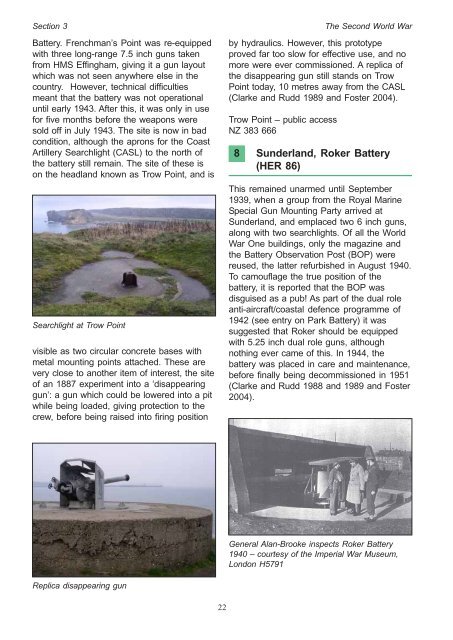TWENTIETH CENTURY DEFENCE SITES of TYNE and WEAR
TWENTIETH CENTURY DEFENCE SITES of TYNE and WEAR
TWENTIETH CENTURY DEFENCE SITES of TYNE and WEAR
Create successful ePaper yourself
Turn your PDF publications into a flip-book with our unique Google optimized e-Paper software.
Section 3 The Second World War<br />
Battery. Frenchman’s Point was re-equipped<br />
with three long-range 7.5 inch guns taken<br />
from HMS Effingham, giving it a gun layout<br />
which was not seen anywhere else in the<br />
country. However, technical difficulties<br />
meant that the battery was not operational<br />
until early 1943. After this, it was only in use<br />
for five months before the weapons were<br />
sold <strong>of</strong>f in July 1943. The site is now in bad<br />
condition, although the aprons for the Coast<br />
Artillery Searchlight (CASL) to the north <strong>of</strong><br />
the battery still remain. The site <strong>of</strong> these is<br />
on the headl<strong>and</strong> known as Trow Point, <strong>and</strong> is<br />
Searchlight at Trow Point<br />
visible as two circular concrete bases with<br />
metal mounting points attached. These are<br />
very close to another item <strong>of</strong> interest, the site<br />
<strong>of</strong> an 1887 experiment into a ‘disappearing<br />
gun’: a gun which could be lowered into a pit<br />
while being loaded, giving protection to the<br />
crew, before being raised into firing position<br />
Replica disappearing gun<br />
22<br />
by hydraulics. However, this prototype<br />
proved far too slow for effective use, <strong>and</strong> no<br />
more were ever commissioned. A replica <strong>of</strong><br />
the disappearing gun still st<strong>and</strong>s on Trow<br />
Point today, 10 metres away from the CASL<br />
(Clarke <strong>and</strong> Rudd 1989 <strong>and</strong> Foster 2004).<br />
Trow Point – public access<br />
NZ 383 666<br />
8 Sunderl<strong>and</strong>, Roker Battery<br />
(HER 86)<br />
This remained unarmed until September<br />
1939, when a group from the Royal Marine<br />
Special Gun Mounting Party arrived at<br />
Sunderl<strong>and</strong>, <strong>and</strong> emplaced two 6 inch guns,<br />
along with two searchlights. Of all the World<br />
War One buildings, only the magazine <strong>and</strong><br />
the Battery Observation Post (BOP) were<br />
reused, the latter refurbished in August 1940.<br />
To camouflage the true position <strong>of</strong> the<br />
battery, it is reported that the BOP was<br />
disguised as a pub! As part <strong>of</strong> the dual role<br />
anti-aircraft/coastal defence programme <strong>of</strong><br />
1942 (see entry on Park Battery) it was<br />
suggested that Roker should be equipped<br />
with 5.25 inch dual role guns, although<br />
nothing ever came <strong>of</strong> this. In 1944, the<br />
battery was placed in care <strong>and</strong> maintenance,<br />
before finally being decommissioned in 1951<br />
(Clarke <strong>and</strong> Rudd 1988 <strong>and</strong> 1989 <strong>and</strong> Foster<br />
2004).<br />
General Alan-Brooke inspects Roker Battery<br />
1940 – courtesy <strong>of</strong> the Imperial War Museum,<br />
London H5791

















